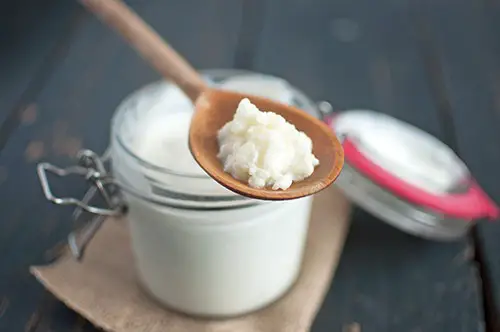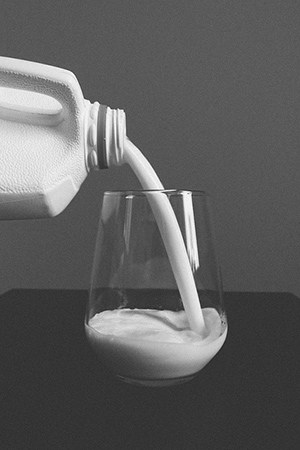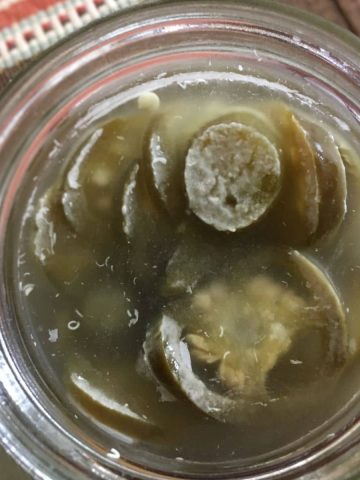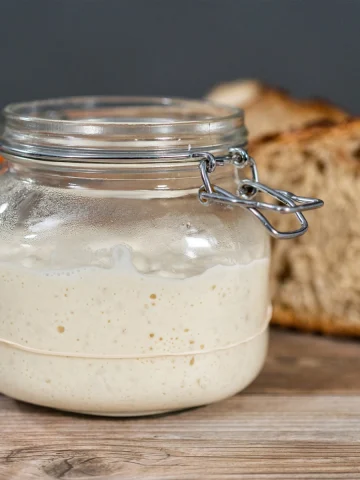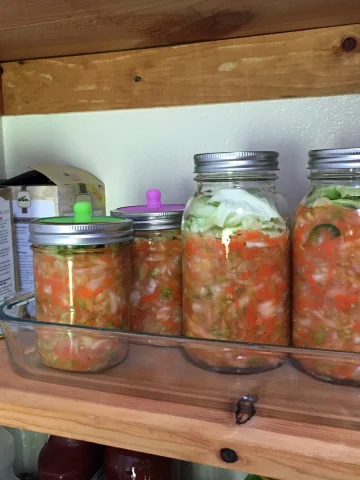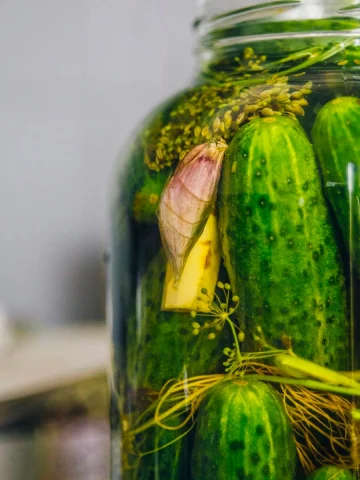The Real Difference Between Kefir and Buttermilk
Kefir and buttermilk are both fermented milk beverages with several touted health benefits, but they have several differences in production, nutrition, flavor, and texture.
Both milk kefir and buttermilk are probiotic-rich drinks full of healthy gut bacteria. The big difference between kefir and buttermilk is in the number of bacterial cultures each offer.
Depending on your variety, milk kefir grains may contain up to 60 strains of good bacteria and yeasts. See the full list here (source).
Jump to:
- Kefir vs. Buttermilk: Nutritional Benefits
- Benefits of Kefir
- Benefits of Buttermilk
- 10 More Health Benefits of Buttermilk
- Taste, texture, and flavors of Kefir and Buttermilk
- How they’re made
- How Kefir is Made
- How Buttermilk Is Made
- How to incorporate Kefir and Buttermilk into your diet.
- Use Kefir and Buttermilk in Your Daily Diet for Better Health
- How To Shop The Grocery Store For Gut Health
While buttermilk only has one strain, either Lactobacillus bulgaricus or Lactococcus lactis, depending on the manufacturer.
So if you are trying to decide which is better for your gut health, then kefir is the answer.
Kefir vs. Buttermilk: Nutritional Benefits
Kefir and buttermilk have quite a few similarities in their nutritional profile. The following stats are for a one-cup serving.
Both kefir and buttermilk contain a similar amount of potassium. An 8-ounce serving of kefir made by Lifeway contains about 376 mg of potassium (source), and 2% buttermilk closely surpasses it with 439 mg of potassium. (source)
| Nutrients | Kefir | Buttermilk |
| Calories | 161 | 152 |
| Protein | 11 grams | 7.9 grams |
| Carbohydrates | 24 grams | 12 grams |
| Fat | 2 grams | 8.1 grams |
| Fiber | 3 grams | 0 grams |
| Total Sugar | 20 grams | 12 grams |
| Potassium | 376 mg | 370 mg |
Benefits of Kefir
Milk kefir is high in lactic acid bacteria (LAB). LAB helps your gut digest lactose easier and regulate bowel movement. LAB's can also help improve immune function, which in turn helps prevent infections, colds, and the flu.
Research has shown that LAB's can prevent and stall the progression of such cancers as colon cancer, leukemia, breast cancer, and skin cancer. source https://www.yemoos.com/blogs/yemoos-blog/lactic-acid-bacteria-vs-acetic-acid-bacteria
Kefir grains are a mixture of bacteria and yeasts in a matrix of proteins, lipids, and sugars. Many say this symbiotic matrix forms grains that look like tiny cauliflower florets. Kefir is packed with many vital nutrients and vitamins.
- magnesium
- riboflavin
- vitamin B12
- phosphorus
- calcium
- protein
- vitamin D
- vitamin K2
- bioactive compounds
- organic acids and peptides
Milk kefir is rich in calcium and vitamin K2, which can increase bone health, and with regular consumption, has been shown to reduce the risk of bone fractures by 81%. (source)
The K2 vitamin helps calcium metabolize and get into the bone to prevent fractures and keep your bones strong,
While it is true kefir is a source of K2, it depends on the quality of the milk used to make the kefir.
If the milk is from grass-fed cows, the amount of K2 will be higher. Furthermore, the bacteria in the kefir grains also produce some K2.
Nailing down the exact amount of K2 that is in kefir was difficult. I found one scientific study that states there are 5 µg/100 g (or 3.5oz.).
However, it did not list the type of milk used in the kefir sample, how much is derived from the milk, or the bacteria also in kefir grains. (source)
Compare that to other sources of K2 (source)
- Natto 939 mcg
- Goose Liver 370 mcg
- Beef Liver 263 mcg
- Kimchi 42 mcg
- Kefir 5 mcg
- Per (100g) or 3.5 oz. of food*
- µg and mcg are the same measurements.
To make a dairy-free version of kefir, you can substitute coconut water, coconut milk or other sweet liquids for the milk.
However, these will not have the same nutrient profile as dairy-based kefir.
Related Topic: Best Brands of Kefir to Buy for Gut Health
Benefits of Buttermilk
A cup of buttermilk can provide you with several surprising health benefits. 2% buttermilk has 250 mg of calcium per cup, which can help prevent osteoporosis, making it especially good for people concerned with bone health. (source)
Buttermilk has the same amount of protein as skim milk and less fat than regular milk because the fat is skimmed off the top of the cream while making butter. The leftover liquid is now lower in fat.
10 More Health Benefits of Buttermilk
Reduced Acidity, Fight Constipation, gave a Cooling Effect, Prevented dehydration, supported Detoxification, Provide Essential Vitamins and Nutrients, was Rich in Calcium, Reduce Blood Pressure and High Cholesterol, and Prevention of Diseases.
Alleviates Several Stomach Ailments
Because buttermilk has acid, it can aid digestion and help clear your stomach. Drinking buttermilk helps reduce stomach ailments like irritable bowel syndrome, stomach infections, irregular bowel movements, lactose intolerance, and colon cancer. (6)
This drink also soothes the stomach lining and cools down the body's digestive tract, thereby reducing body heat.
It can even lower blood pressure and cholesterol.
Buttermilk is full of electrolytes and is a great drink to prevent dehydration.
If you are working out in the hot summer sun, buttermilk can help the body maintain its fluid content. It is very versatile since you can buy it in several different forms. Fresh, frozen, and powdered are all available on the market, making them easy to incorporate into any recipe.
Taste, texture, and flavors of Kefir and Buttermilk
Buttermilk and kefir have similar tastes, with kefir being a bit tangier. Buttermilk tastes very tart and sour, similar to unsweetened yogurt or sour cream.
They both have a similar appearance, a white liquid that could be tinged with a slight yellow or brown.
They may have bubbles, and they’re known for having a thick and creamy texture, much thicker than regular cow’s milk.
You may also notice a slightly sour scent, but don’t be alarmed again. It’s perfectly normal, and drinking it won’t hurt you, and you just may find yourself a little bit surprised by the flavor and scent.
It’s worth it for the health benefits you’ll receive by incorporating it into your regular diet, and there are plenty of ways to use both drinks that don’t involve drinking it straight if you find yourself truly put off by the flavor.
How they’re made
Both kefir and buttermilk require a starter material to undergo fermentation, during which bacteria, yeasts, or other microorganisms break down glucose molecules or sugar.
How Kefir is Made
Homemade kefir starts with grains that are small colonies of proteins, yeast cultures, sugar, and bacteria. Fresh milk is added to the grains and left to sit out at room temperature overnight.
It doesn’t necessarily need to be cow’s milk, sheep or goat milk can also be used.
Once the kefir has fermented for approximately 12 -24 hours, the active cultures are strained. What is left behind is a smooth and tangy flavored drink that is now a good source of probiotics.
How Buttermilk Is Made
Cultured buttermilk has been around for hundreds of years and was originally made with unpasteurized cow’s milk. People would make butter by letting the whole milk stand to allow the cream to separate.
After the cream rose to the surface, it was skimmed off, leaving “skim milk” behind.
Buttermilk is the byproduct or liquid left behind from making butter from cream. As you can probably guess, this process was not sterile, resulting in a natural fermentation of the skim milk.
The lactose, and milk sugar in the cream, would mix with bacteria in the air. It would then metabolize into lactic acid, which is the reason for the tangy flavor.
Today, buttermilk is made by adding lactic acid to pasteurized skim milk to increase acidity. This acidification gives the buttermilk its unique, tart taste and adds additional proteins to the milk.
How to incorporate Kefir and Buttermilk into your diet.
Now that you have all the details about these two popular dairy products, you’re probably wondering what the best way is to incorporate each one into your diet.
Of course, you can drink each just as they are, and it’s probably the most efficient way to do it, but why not have a little fun with it? Your food doesn’t have to be boring.
Buttermilk is a great substitute for butter or sour cream, especially because it has a yogurt-like flavor.
Add buttermilk or kefir to your smoothie.
A simple smoothie recipe to include these in your diet might look like ½ cup of kefir or buttermilk, ½ cup of frozen strawberries, one tablespoon of lemon juice, and one teaspoon of honey, and run it through a blender.
You could add some cacao nibs or chia seeds to the recipe. It sounds like the perfect start to a morning. Try our banana kefir smoothie recipe and strawberry kefir smoothie.
Kefir makes fantastic bread, like lemon loaves or carrot loaves. You can use them as a sourdough starter if bread baking is your thing.
Both make excellent meat tenderizers.
To make a deliciously moist chicken on the inside and crispy outside, first, soak the chicken breast in kefir or buttermilk.
Kefir or buttermilk can also be used for frozen treats like ice cream or popsicles.
Buttermilk adds a nice undertone of tang and creaminess to any homemade salad dressing. Try this ranch dressing recipe.
Incorporate buttermilk into your favorite ranch dressing is all-natural, loaded with buttermilk and fresh herbs, quick and easy to make, and SO delicious that you'll never go back to store-bought again!
Make your favorite salad dressings into a delicious and creamy blend and pour over a bed of collards, kale, and mustard greens for a Southern-inspired summer salad.
Buttermilk pancakes and buttermilk biscuits are two tried and true recipes.
Kefir also comes in flavored fruit varieties, so as long as you’re mindful of your sugar intake, that could be a great option.
Both drinks have amazing qualities and very similar nutritional profiles. However, because kefir is made up of approximately 60 strains of beneficial bacteria and yeasts compared to buttermilk’s one strain of good bacteria, I believe kefir is your best option.
You’ll know that you’re making a great choice with your health in mind, and you can look forward to reaping the benefits every time you use them.
Use Kefir and Buttermilk in Your Daily Diet for Better Health
Both kefir and buttermilk are good sources of probiotics. Probiotics are living microorganisms that help balance the good and bad bacteria that live in the digestive system.
Good bacteria in the gut ensure the appropriate absorption of vitamins and minerals and synthesizes them as well.
A well-functioning gut with healthy gut flora holds the roots to good health; the rest of the body cannot thrive without a well-functioning digestive system.
A healthy gut provides a more balanced metabolism, body weight, and a stronger immune system.
It also helps produce essential vitamins and nutrients for your body, improves brain function, and elevates your mood.
The diverse and multiple functions of gut flora reach far beyond the gut itself. A build-up of negative microbes or bad bacteria in our digestive system can cause toxicity build-up. So, no matter what you do, you can’t get better. (source)
One of the easiest ways to balance your gut microbiome is by consuming fermented foods, i.e., kefir and/or buttermilk.
How To Shop The Grocery Store For Gut Health
Eating various fermented foods with live probiotics can have powerful benefits for your body and brain. Check out my posts on choosing the right fermented foods with probiotics in the grocery or shopping online.

